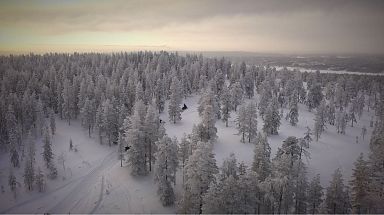Smart Regions heads to Europe's frozen wilderness to find out about a sustainable tourist project that aims to protect Europe's fragile Arctic ecosystem.
In recent years Europe's icy Arctic wilderness has become an increasingly popular holiday destination. But is it really possible to manage growing numbers of tourists in such a fragile ecosystem?
A cross-border project between Finland, Sweden, and Norway called Visit Arctic Europe is attempting to do just that. Since 2015, it's brought together 120 companies and a dozen tour operators in a bid to better protect the pristine environment.
Fishing on ice
Kevin and his family had always dreamt of a trip to the Arctic. When we meet him in Finland, he and the others in his group have travelled on snowmobiles for an hour to experience traditional fishing on a frozen lake.
A key requirement is that companies involved in Visit Arctic Europe are asked to do something that makes their business more sustainable. In this instance, the engines in the snowmobiles Kevin and the group are using are less polluting than standard ones.
“It is my first time here and actually what attracted me was the wide-open spaces and the beauty of the landscape... especially the beautiful walks and things like that, for example, we’re are ice fishing. I haven’t caught anything yet, but I’m sure I will,” Kevin said.
Supported by the European programme Interreg Nord, since 2015 the project has received nearly 13 million euros.
"Our companies in the project, they saw three very important issues we need to concentrate [on]. One is that we buy locally; we reduce the impact on nature and we honour our heritage, cultural and social heritage, of the region. These are the three most important things we concentrate on in the project," said Posio.
Reindeer herder and farmer Miia supports that desire to showcase the region's unique customs and culture.
As a member of the Sami Nordic indigenous people, she believes that it's vital for visitors to understand the indigenous way of life.
"We have our own language, it is spoken by 500 people. We are a very small minority. And these colours show that I am Inari Sami. In our culture, it is very important to respect nature. Therefore, I think it's important to share it for people and show that we exist. We are the only native people in the Nord European Union area."












